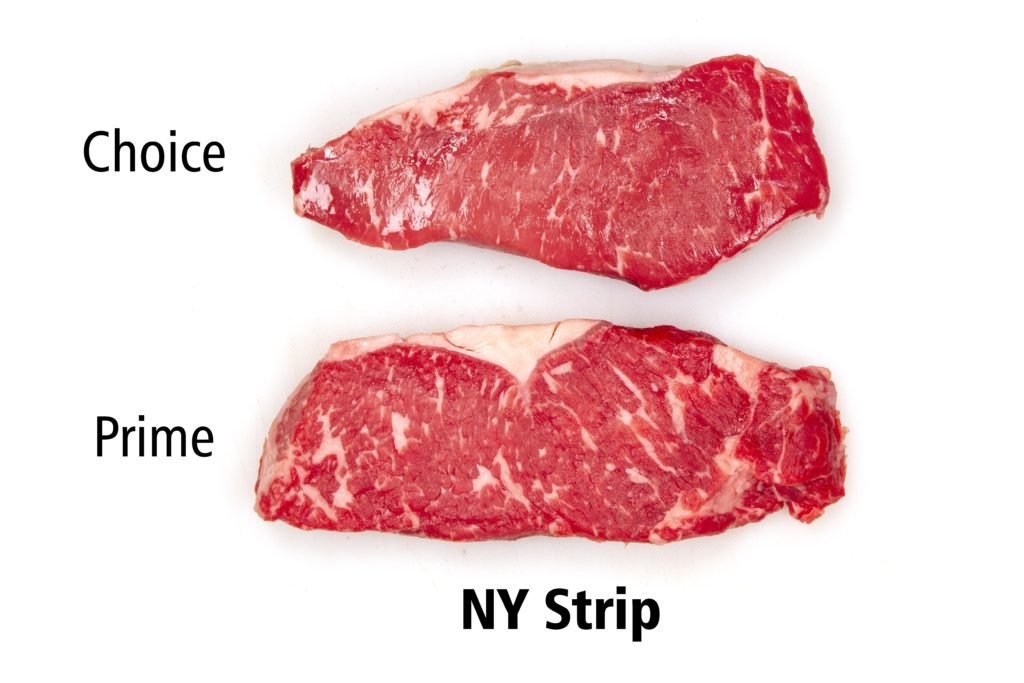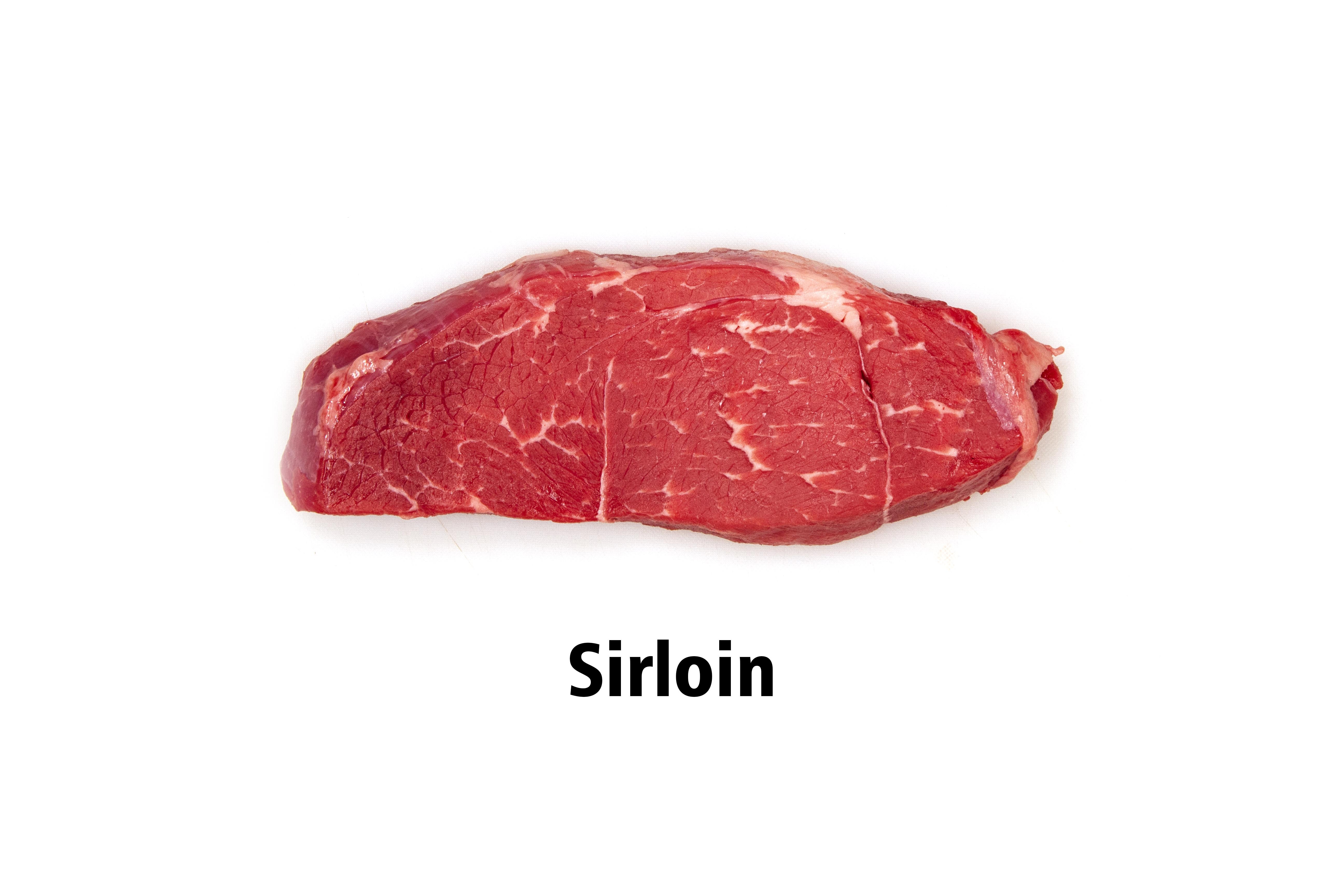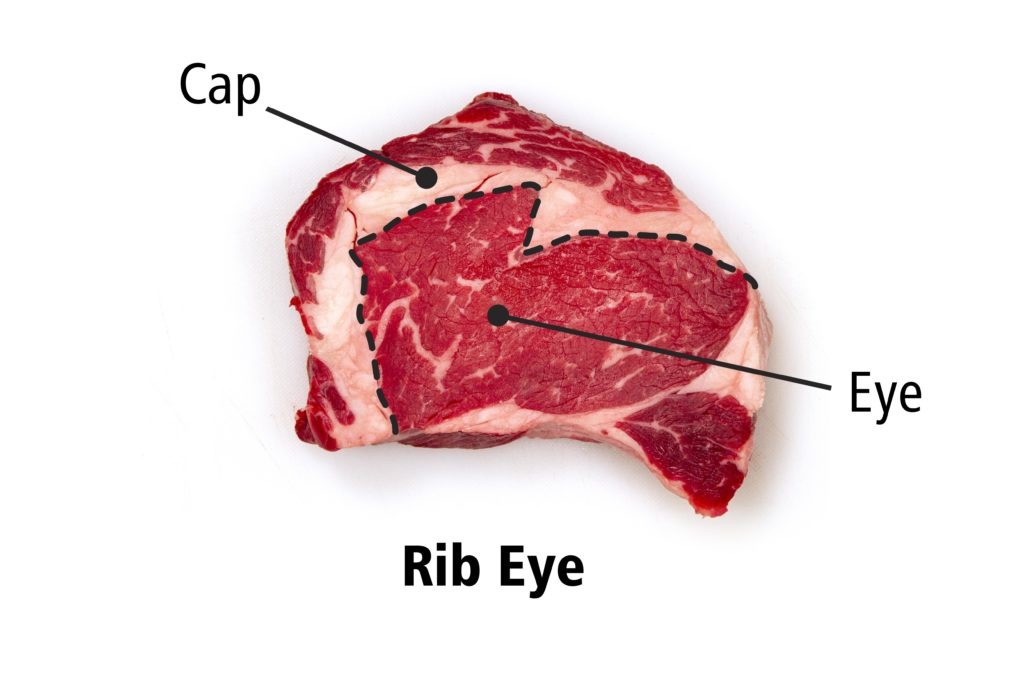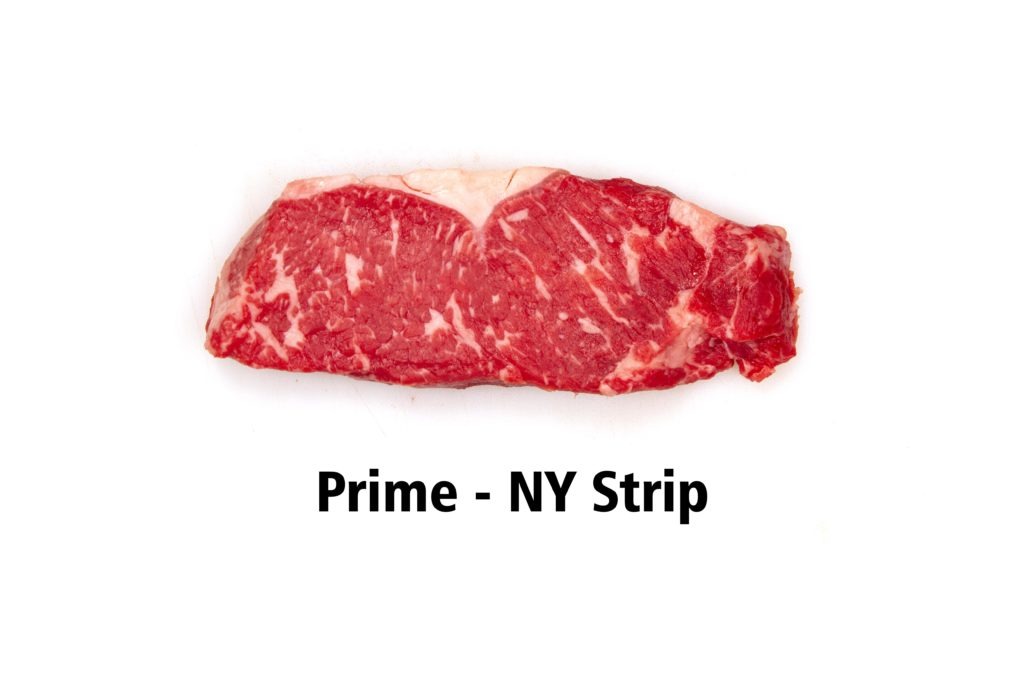1. What Internal Temperatures Correspond to Rare, Mediums, and Well-done Beef?
When Americans go out to celebrate, there'southward normally one thing on their minds: Steak. Whether at a mega-concatenation steakhouse or a high-cease, gourmet restaurant, people often accomplish for a large, juicy steak when they have a reason to splurge. And why not? If you lot're going to a fancy restaurant, why not order the near expensive slice of meat on the card?
Only there is a problem with so many people eating steak only for special occasions, and that problem is that many of those people only go out to eat for those special occasions. Chances are if they usually go out, it's not to a fine-dining establishment, and when they arrive at one they might experience uncomfortable with the menu. Such customers aren't usually the adventurous blazon. They're not likely to lodge the Chef's roast duck leg with parsnip ragout and orange-flower water raspberry gastrique. They desire something familiar, something comforting, something that says fine dining and loftier grade without involving likewise much risk. Many of them opt for steak. In professional person kitchen lingo, these diners are known equally amateurs.
At present, you are not one of them, merely if you get out to a nice restaurant, they are out there and yous will reap their sowing. Amateurs inspire most kitchens to put a steak on the menu, and if yous social club the steak, those kitchens might make a statistical assumption that y'all don't know what you're doing when you order. So if you want to make sure y'all don't get the brusque end of the steak when you become out for a nice dinner, you lot need to be able to order steak like a pro, and that's what we're here to talk to you about today.
Welcome to our Guide to Steak. Whether yous'll exist joining the hoards at the fine dining establishments or searing up your ain juicy cuts at home, we've got you covered. We'll review the dissimilar cuts of steak, steak doneness temperatures, of course, and even how to pick out a steak at your local butcher or grocery store. Then settle in, things are about to go meaty.
First Things First: Steak Temps
Permit'due south first lay down some scientific discipline to build on. Meat is made of muscle fibers. Those musculus fibers are bundles of various kinds of protein fibers. When those proteins are heated past a certain point, their shape changes in a procedure called "denaturing." This is what cooking meat is all about. Past applying heat to the meat we fundamentally change its structure and composition, thus altering flavor and texture until a raw piece of meat becomes palatable.
When the poly peptide fibers in meat reach 130°F (54°C) they begin to tighten, coiling up and packing themselves more than tightly. As the proteins coil and tighten, they expel water, like a sponge beingness wrung out. The hotter the temperature above that 130°F (54°C) threshold, the tighter the squeeze and the more water lost.
If y'all heat a steak beyond to 140°F (60°C), the red myoglobin in the meat will start to denature and turn a darker, greyness-brown color. The long protein fibers will move beyond tightening and starting time to shrink, expelling even more water.
And this brings us to the steak doneness. When your waiter asks you how you'd like your steak done, don't answer by maxim that yous'd like it "with some pinkish." "Some pink" isn't a measure of actual doneness, and, to be frank, requires someone to cutting into your steak to peek within.
Social club with the standard arrangement of rare, medium-rare, medium, medium well, or well-done. I'll go into these gradations in detail below, but first I want to make something very clear: based on what we've merely gone over above, if you lot don't desire to audio similar an apprentice, don't social club a steak that is both well done then mutter when it isn't juicy! No amount of cooking skill can overcome the physics at play in the protein structure of the steak.

Steak Doneness Temperature Chart
| Preferred Doneness | Degrees F | Degrees C |
|---|---|---|
| Rare | 120-129°F | (49-54°C) |
| Medium Rare | 130-134°F | (55-57°C) |
| Medium | 135-144°F | (58-62°C) |
| Medium Well | 145-154°F | (63-67°C) |
| Well Done | 155-164°F | (68-73°C) |
It is important to note that the temperature is the key to doneness, non the color. And so while I describe the coloration of each doneness below, keep in mind that at that place are other factors that tin can impact the color of the meat regardless of actual doneness. It is possible to have a medium-well steak that is quite
(For more on steak doneness, come across our article on steak temps.)
Rare steak temp 120–129°F (49–54°C)
A rare steak is ordinarily very cerise in the center that can even so be cool to the impact. It is just past raw in the center and has a texture that is not everyone's cup of tea. The flavor, undeveloped by cooking, tin exist somewhat iron-y.
Medium-rare steak temp 130–134°F (54–57°C)
Medium rare usually has a warm scarlet center. This is widely best-selling every bit the sweet spot of juiciness and texture, providing the diner with a pleasant mouth-feel, good flavor development beyond rare, and less "ick" cistron for some.
Medium steak temp 135–144°F (57–62°C)
The heart of a medium-cooked steak is very warm and is usually pink, not red. It volition be firmer (read: tougher). Information technology volition seem juicier, in that when you lot cut information technology, juices will run out of it. Merely those juices have been squeezed out of the fibers. And then while you will meet juices on the plate, the steak itself volition have a slightly lower h2o content in the meat and be drier and chewier.
Medium-well steak temp 145–154°F (63–68°C)
This is where things really kickoff to change quickly. The protein fibers in the muscles shrink dramatically and the steak loses much of its volume. (The truth is, if you social club a steak medium well, no matter how much you really like information technology that fashion, the kitchen will think yous have no idea what food is supposed to taste similar. It'south non fair, simply information technology's how it works.) This steak will usually exist just slightly pink in the centre and will have lost much more than of its juices to the fire.
Well done steak temp 155°F+ (69°C+)
At this doneness, the proteins in the steak are completely denatured and the natural juices are drained. Nearly of the tenderness is gone and any that remains is only due to the lack of connective tissues. With almost no native liquid left in the meat to carry its flavors to the remotest corners of your mouth, it is harder to get the full flavour of the beef. That being said, many people do similar their steaks cooked this style and, while we disagree, nosotros wish them well.
It's worth knowing, past the way, that y'all volition make the kitchen staff angry if you society a quality steak well done—non just considering they consider it to be a waste material of the nutrient itself, merely also because on a busy night—maybe a weekend or another important dining-out nighttime similar Valentine's Day—you're too slowing down the line, holding upwards other reservations, and generally throwing a wrench in the gears.
When y'all social club your steak, it is best, in most situations to guild information technology simply co-ordinate to the above levels. Don't say "medium-rare plus." That'due south not a thing. Medium rare is merely 5°F (ii.8°C) wide. If you endeavour to put a "plus" on that in a decorated service, y'all're getting medium.
Even meliorate, of course, is to lodge your steak exactly to temperature. Non all kitchens volition be equipped to handle this request, merely it'southward worth a shot. I like my steak to come up off the grill at 125°F (52°C), and I'll even enquire for it that way when dining out. If the waiter looks at you similar you're s
Carryover cooking in steaks:
The temperatures listed above are final temperatures. Because of the high-heat cooking environments for steak, it'south best to pull them about 5–vii°F (3–4°C) early on to permit for carryover cooking. You don't need to tell your waiter that, but you do need to know it if you're cooking at home!
Buyer's Guide to Steak Cuts
Of course, staying domicile and cooking dinner yourself is a great idea, too. To exist honest, yous can probably brand a steak that is every bit equally good—nay, even ameliorate than—most of the steaks y'all volition get at a busy restaurant. Here we'll talk about the most common steak cuts and what to expect for when you lot buy a steak to cook at home. Merely remember to use the temperature guide above and the Super-fast® Thermapen to cook your steak to your perfect preferred doneness.
Beef grades: what do they mean?
To buy a good steak, you lot demand to sympathise what the grades of beef mean and what they don't mean. The USDA established beefiness grading in 1917 to ensure quality beef was being shipped to the front during WWI. It later continued the exercise to ensure quality on steamships and railcars. The grading arrangement has undergone changes since the early 1900s, though many of the terms we utilize at present were established by the early 1940s. Though inspection for "wholesomeness and safety" is mandatory and carried out by the Food Safety and Inspection Service (FSIS), meat grading is voluntary and paid for by the producer.
The grading organisation you run into as a consumer has ii basic parts: a letter grade indicating the age of the animal and another grade that indicates the level of marbling.
Though it is less mutual to see it in meat cases or at butcher shops, the letter grade indicating age is useful. If your meat department labels it, know that Form A beef is from an animal 9 to thirty months old, Class B from 30 to 42, on down through Grade E, which is over 96 months old. Highest quality beef is usually Grade A.
Marbling scores, what nosotros commonly know equally steak "grades," are given to determine the "palatability" of the beef, a term that includes tenderness, gustatory modality, and the
The highest course is Prime number, followed past Choice, Select, Standard, Utility, Cutter, and Canning. Prime number beef has the most inter-muscular fat marbling, followed by option, so on.
Below you tin can see a comparison of ii strip steaks: one prime grade, the other selection.

From the USDA website we can learn about the grades and how they are used:
- Prime grade is produced from young, well-fed beef cattle. It has abundant marbling and is generally sold in restaurants and hotels. Prime roasts and steaks are first-class for dry-heat cooking (broiling, roasting, or grilling).
- Choice course is high quality, but has less marbling than Prime. Pick roasts and steaks from the loin and rib volition exist very tender, juicy, and flavorful and are, like Prime, suited to dry out-oestrus cooking. Many of the less tender cuts, such as those from the rump, round, and blade chuck, tin also be cooked with dry heat if not overcooked. Such cuts will be most tender if "braised" — roasted, or simmered with a small-scale amount of liquid in a tightly covered pan.
- Select form is very compatible in quality and unremarkably bacteria than the college grades. It is fairly tender, merely, because it has less marbling, information technology may lack some of the juiciness and flavor of the higher grades. Just the tender cuts (loin, rib, sirloin) should be cooked with dry estrus. Other cuts should be marinated before cooking or braised to obtain maximum tenderness and flavor.
- Standard and Commercial grades are often sold as ungraded or as "store brand" meat.
- Utility, Cutter, and Canner grades are
seldom,
— USDA, https://www.fsis.usda.gov/wps/portal/fsis/topics/nutrient-safe-education/go-answers/food-prophylactic-fact-sheets/production-and-inspection/inspection-and-grading-of-meat-and-poultry-what-are-the-differences_/
The grading of beefiness says naught—at to the lowest degree not anything directly—about how the beefiness was fed or raised. Grass fed beef tends to be leaner than grain fed beef, and so information technology will not usually receive high grades similar prime. If you want to ensure that beef is handled a certain manner, the grading will not tell y'all. You lot have to become to know the sources for the beef itself. Getting to know a local producer or small-calibration butcher is the all-time style to learn more about how your beefiness is produced.
A guide to steak cuts

Let's take a look at the major steak cuts now, then you can know what to expect for and what to avoid at your local butcher or meat section.
Sirloin

The sirloin is the former-school steak—the large man, large hunger steak of our grandfathers. Information technology comes from the rear half of the loin and, while tender, isn't equally tender every bit its neighboring cousin, the strip steak. The sirloin is also rather vague when it comes to quality: the sirloin department of the moo-cow offers steaks of various constitutions, depending on their location. Peak sirloin is of very adept quality and is very tender, while lesser sirloin is tougher. Many sirloin steaks have a fibrous membrane running through them, making them less appealing (and therefore somewhat cheaper) than some other cuts.
Sirloin is also rather lean, which is good if you are trying to eat more healthily, but also ways that it has less resistance to overcooking. (Inter-muscular fatty acts every bit a buffer against overcooking by melting and contributing to a pleasant oral fissure-feel. Leaner cuts must be more wary of exact temperatures than fattier cuts.)
If you desire a big slice of beefiness that is pretty tender and has adept beefy flavor, but also doesn't break your budget, sirloin might be correct for you.
Rib eye

Ribeye is one of the great cuts on the whole cow. Information technology's well marbled with fat and has big deposits of fatty that contribute to the richness of this steak. The fatty in a rib centre is particularly tasty, with a characteristic drool-inducing flavor and odor. Rib eye can be purchased either bone-in or boneless. If y'all similar very large cuts get a tomahawk steak, which is a very thick rib eye with a long bone fastened to it.
The rib center steak is composed of two main muscles, the eye and the cap. The eye is compact and tender, but the rib eye cap is a truthful delight. It has a tender, almost soft/spongy texture and a deep, intense flavour. When shopping for a rib eye steak, wait for something with good marbling in the eye and every bit thick a cap department as you can notice.
If you desire a fool-proof method for cooking them, try our tips for smoking and contrary searing your rib centre steak. (If you don't want to smoke it, use the same ii-footstep procedure in your home oven.)
(New York) strip

The strip steak comes from the "curt loin" of the steer and is widely beloved. A nicely portioned, meaty strip steak is a joy to eat, with good tenderness and sharper, beefier flavour than the ribeye or the filet. Strip steaks can exist prepared either bone-in (Kansas City strip) or boneless (NY strip). The same principles apply to the strip every bit the ribeye when it comes to basic.
When looking for a strip steak, look for a uniform appearance to the meat, with the grain not seeming to switch directions halfway across the steak. And, if possible, avoid steaks that have an "middle." The eye is a section of meat that is offset by a fibrous, chewy membrane.

In full general, a strip steak is a great option that is neither too fancy nor too plain. To learn more about cooking it correct, look at our post on NY strip steak temps.
Filet mignon

Ah, the filet—the jewel in the crown of the steak world. The filet (too called filet mignon) is cut from the beefiness tenderloin. If you lot want to save money and go several skilful steaks, I recommend you do a lilliputian dwelling butchering and following our instructions for cutting and cooking your own filet mignon steaks.
The filet is über tender, with a texture that is often, and with just slight exaggeration, described as beingness like butter. Its ane flaw is that it is quite mild tasting. At that place is less sharp beef from the meat itself and it has none of the deep richness of the rib centre. Without a skilful sear, the filet can exist pallid and tiresome. With a good sear, it is a treasure.
Of course, filet is one of the most expensive steaks. Y'all become virtually 12 skilful filets from a whole cow, and that is reflected in the cost.
When buying a filet, wait for the about marbling you lot tin can detect, and be wary of whatever seams you may encounter in the meat. If there is a membranous seem, they've probably cut too far into the chateaubriand section of the tenderloin, and y'all're getting some chewier bits.
Note that a filet should never really be cooked past medium-rare because it is quite lean and the texture suffers badly when it is cooked even equally far every bit
T-bone

The T-bone steak is where steaks kickoff to go even more extravagant. It is composed of a strip steak, the accompanying bone, and a little bit of the tenderloin on the other side. It is, in fact, a Kansas City strip steak with a bite of filet. These steaks are large and celebratory, evoking prosperity and fullness. They can be challenging to cook properly, because the filet chip volition tend to overcook while the strip section is nonetheless coming upward to temperature. Careful temperature management and a two-stage, opposite sear cook is really the way to go for this and the porterhouse.
When shopping for a T-bone, try to go the biggest department of tenderloin that you can. Be sure that the bone is cut evenly, with no $.25 sticking up above the surface of the meat which would prevent the steak from lying flat in a hot cast-iron pan. (That shouldn't be a trouble ordinarily, only watch out for it!) Of course, you lot tin can always grill information technology!
Porterhouse

The porterhouse is a T-bone on steroids (not literally). Where the T-os is a strip steak with a little filet thrown in for good measure, the porterhouse is a strip steak with a whole filet attached. It is two steaks in 1, and that explains why it feels similar y'all pay for two steaks when you buy i of these!
As mentioned above, there is some difficulty cooking the two different muscles properly. If you must err, err on the side of perfecting the tenderloin department. Again, a contrary sear is probably the best way to assure perfection with the porterhouse. Just other methods practice piece of work very well. In fact, we also recommend broiling your porterhouse!
Considering of its location in the loin, it is hard to find a porterhouse with a large section of filet that doesn't likewise have at least some "eye" on the strip section. Look for a steak with a proficient remainder between a large filet and a small eye, and, every bit always, expert marbling.
The porterhouse is huge, and therefore a great steak for sharing.
Steak thickness
A word on steak thickness. Many grocery store meat departments offer "deals" on steaks that look appealing—ordinarily something similar an viii oz steak for $6. This seems like a great deal because it's a steak dinner for six bucks, but those steaks are often very thin—possibly even as thin as ½-inch. It is very hard to cook a thin steak correctly. By the time you've seared both sides, it'due south already cooked to well done in the middle. For a properly seared steak with expert flavour, you should get steaks that are at least 1 inch thick. This is true for all cuts of steak. That might hateful ownership a steak that is besides large for you to swallow all by yourself, just you tin can ever share one large steak between ii people.
Whew! That'due south a lot of information about steak, and information technology may seem overwhelming, but at that place are just a few key things to recollect.
- Always buy the best beef yous can afford. Prime beef tastes better than pick course, and
choice is better than select. That makes your repast thatmuch easier to get right. - No matter what class you buy or what cut y'all cull, remember that it is not time or colour that determines the doneness of a steak, but the internal temperature. Whether it'southward sous vide cooking, grilling or searing your steaks, or simply ordering steak in a eating place, know your preferred doneness temperatures.
- Tools similar the Thermapen enable both you and your chef to have the control needed to melt steaks perfectly every fourth dimension.
Get those things correct and you can celebrate whatever twenty-four hour period with meat washed right, courtesy of ThermoWorks.
Shop now for products used in this post:
Source: https://blog.thermoworks.com/beef/steak-temperatures-ordering-and-buying-guides/

0 Response to "1. What Internal Temperatures Correspond to Rare, Mediums, and Well-done Beef?"
Post a Comment